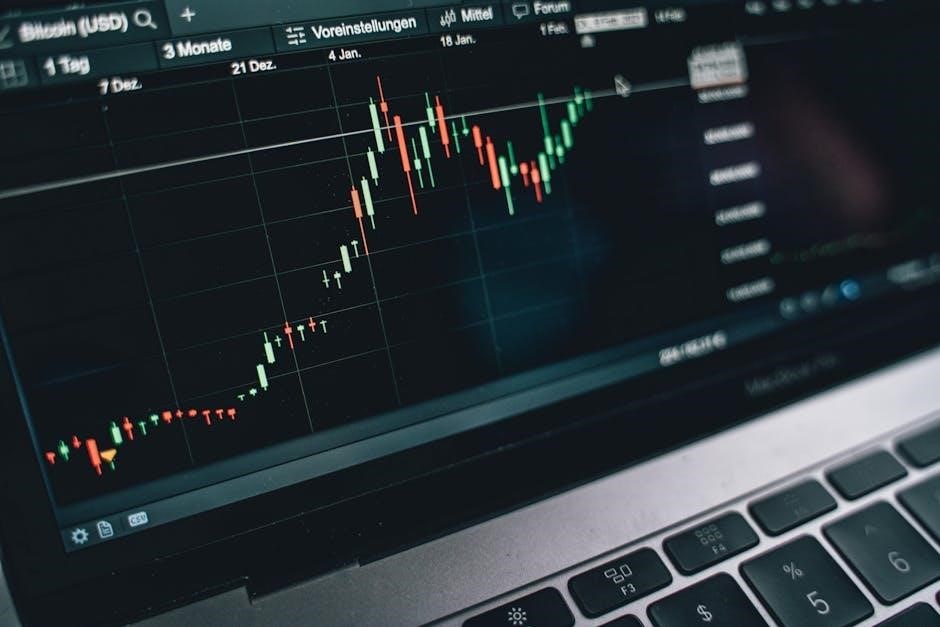a complete guide to the futures markets

Futures markets enable investors to trade contracts obligating them to buy or sell assets at predetermined prices and dates, facilitating risk management and speculation in global markets.
1.1. Overview of Futures Markets
Futures markets are platforms where standardized contracts are traded, obligating parties to buy or sell assets at set prices and dates. These markets facilitate risk management, speculation, and price discovery; Assets range from commodities like oil and gold to currencies and financial instruments. Futures exchanges, such as the Chicago Mercantile Exchange (CME) and Intercontinental Exchange (ICE), oversee trading, ensuring transparency and fairness. Traders use these markets to hedge against price volatility or speculate on market movements. The contracts are binding, with physical or cash settlements. Futures markets operate globally, enabling access to diverse asset classes and fostering efficient price determination. They are integral to modern financial systems, offering opportunities for both institutional and individual traders.
1.2. Importance in Global Finance
Futures markets play a pivotal role in global finance by enabling efficient price discovery, risk management, and speculation. They allow participants to hedge against price volatility, ensuring stability in commodity and financial markets. By providing a platform for locking in future prices, futures contracts help businesses and investors manage exposure to fluctuations in currencies, commodities, and indices. This mechanism fosters market liquidity and transparency, which are critical for the smooth functioning of global financial systems. Additionally, futures markets serve as indicators of economic trends, offering insights into market expectations. Their role in facilitating access to diverse asset classes makes them indispensable in modern finance, supporting economic growth and stability worldwide.
Key Concepts in Futures Trading
Futures contracts are legally binding agreements to buy or sell assets at set prices and dates, enabling risk management, speculation, and efficient market participation with standardized terms.
2.1. Definition and Basic Principles
Futures contracts are standardized agreements to buy or sell an underlying asset at a predetermined price and date. These contracts are traded on regulated exchanges, ensuring transparency and liquidity. The basic principle revolves around the obligation to fulfill the contract terms, making them distinct from optional derivatives like options; Futures markets operate on margin, requiring traders to post a fraction of the contract’s value to control positions. This leverage amplifies potential gains and losses, making risk management critical. The standardized nature of futures ensures consistency in contract terms, facilitating efficient trading and hedging strategies. Understanding these principles is essential for navigating futures markets effectively.
2.2. Differences from Other Derivatives
Futures contracts differ significantly from other derivatives like options, forwards, and swaps. Unlike options, futures are binding agreements to buy or sell an asset at a set price, with no right to walk away. They are standardized, traded on exchanges, and subject to daily settlement, reducing counterparty risk. Forwards, in contrast, are customized over-the-counter (OTC) contracts between two parties. Swaps involve exchanging cash flows and are typically OTC as well. Futures also differ in their margin requirements and the ability to close positions before expiration. These distinctions make futures more accessible and transparent, appealing to both hedgers and speculators seeking precise risk management tools.
2.3. Role of Futures Exchanges
Futures exchanges act as centralized platforms where buyers and sellers trade standardized contracts, ensuring transparency and fairness; They establish rules, monitor trading activity, and enforce compliance to maintain market integrity. Exchanges also provide clearing services, mitigating counterparty risk by acting as intermediaries. They standardize contract terms, such as pricing, delivery dates, and quantities, to facilitate efficient trading. Additionally, exchanges oversee dispute resolution and ensure fair pricing mechanisms. For example, Nasdaq charges membership fees and trading rights fees, highlighting the operational costs and regulatory oversight involved. These platforms are critical for enabling smooth and organized futures trading, protecting participants, and maintaining trust in the markets.

How Futures Contracts Work
Futures contracts are standardized agreements to buy or sell assets at set prices and dates. They facilitate efficient trading through exchanges, with defined terms and margin requirements.
3.1; Contract Specifications
Futures contracts are standardized agreements detailing the terms of trades, including the underlying asset, size, expiration dates, and settlement procedures. These specifications ensure clarity and consistency, enabling efficient trading. For example, crude oil futures might specify delivery in barrels, while gold futures outline ounces. Expiration dates determine when contracts must be settled, and settlement can occur through physical delivery or cash payments. Standardized contract sizes and terms facilitate fair pricing and reduce counterparty risks. Clear specifications also help traders understand obligations, making markets more accessible and transparent. This structure is crucial for maintaining order and confidence in futures trading across global exchanges.
3.2. Pricing Mechanisms
Futures pricing mechanisms are driven by supply and demand dynamics in the market, reflecting anticipated future price movements. Prices are influenced by factors such as the underlying asset’s value, market expectations, and arbitrage opportunities. The relationship between spot and futures prices often determines pricing trends, with futures contracts typically priced at a premium or discount to the spot price. Additionally, cost of carry, including storage and interest costs, impacts pricing. Futures exchanges provide transparent and standardized pricing frameworks, ensuring efficient price discovery. Market participants use these mechanisms to hedge risks or speculate on price movements, making futures markets a vital tool for price risk management and investment strategies.
3.3. Settlement Methods
Futures contracts are settled either through physical delivery or cash settlement, depending on the underlying asset. Physical settlement involves delivering the actual asset, common in commodities like oil or gold. Cash settlement, used for financial futures, calculates the difference between the contract price and the market price at expiry, with payments made in cash. Clearinghouses oversee settlements, ensuring adherence to exchange rules and mitigating default risks. They act as intermediaries, holding margins and facilitating smooth transactions. These methods ensure market efficiency and transparency, crucial for maintaining investor confidence and operational integrity in futures trading. Understanding settlement processes is vital for effective risk management and strategic trading decisions.
Types of Futures Contracts
Futures contracts are categorized into financial, commodity, currency, and index futures, allowing investors to gain exposure to various assets, from agricultural commodities to global currencies and stock indices.
4.1. Financial Futures
Financial futures are contracts based on financial instruments such as indices, currencies, and interest rates. They allow investors to hedge against risks like interest rate fluctuations and currency exchange rate changes. For example, futures on the S&P 500 index enable traders to speculate on stock market movements without owning individual stocks. Similarly, Eurodollar futures are widely used to manage exposure to short-term interest rates. These contracts are traded on regulated exchanges and provide a platform for both hedging and speculation. They are popular among institutions and individuals seeking to manage financial risk or capitalize on market trends. Their versatility makes them a cornerstone of modern financial markets.
4.2. Commodity Futures
Commodity futures are contracts to buy or sell physical goods like crude oil, gold, or agricultural products at a set price and date. These contracts allow producers and consumers to hedge against price volatility, ensuring predictable revenues or costs. Investors speculate on commodity price movements, leveraging futures for exposure to energy, metals, and soft commodities. Platforms like Think or Swim provide tools to analyze and execute trades, while daily settlement times offer transparency. Commodity futures are essential for risk management and accessing global commodity markets efficiently, making them a cornerstone of futures trading strategies.
4.3. Currency Futures
Currency futures are contracts obligating the purchase or sale of a specified amount of foreign currency at a predetermined price and date. They enable investors to hedge against exchange rate risks or speculate on currency fluctuations. Unlike spot markets, currency futures are standardized and traded on regulated exchanges, offering transparency and efficiency. Companies use these contracts to lock in future exchange rates, protecting against adverse currency movements. Traders also leverage currency futures to capitalize on geopolitical or economic trends affecting currency values. Understanding currency futures is essential for navigating global markets effectively, as they provide a powerful tool for both risk management and profit opportunities.
4.4. Index Futures
Index futures are contracts based on the value of financial indices, such as the S&P 500, Nasdaq, or Dow Jones. They allow investors to gain exposure to the performance of an entire market or sector without owning individual assets. These contracts are widely used for hedging against market risk and for speculative purposes. For example, buying a futures contract on the S&P 500 index allows an investor to profit from a potential rise in the U.S. stock market. Index futures are also popular due to their liquidity and the ability to leverage positions, making them a key tool for both institutional and retail traders.

Advantages and Risks
Futures trading offers efficient market access and risk management but involves high volatility and leverage, posing significant potential for losses alongside opportunities for gains.
5.1. Benefits of Futures Trading
Futures trading offers numerous advantages, including efficient price discovery, liquidity, and the ability to hedge against price risks. It allows investors to gain exposure to various assets, such as commodities, currencies, and indices, with leverage, amplifying potential returns. Futures contracts provide a standardized and regulated framework, ensuring transparency and fairness. Additionally, they enable market participants to speculate on price movements, making them a versatile tool for both risk management and profit generation. The ability to trade globally and access diverse markets further enhances their appeal. Overall, futures trading is a powerful instrument for managing risk and capitalizing on market opportunities effectively.
5.2. Potential Risks and Challenges
Futures trading involves significant risks, including market volatility, leverage, and liquidity challenges. High leverage can amplify losses as well as gains, leading to substantial financial exposure. Additionally, rapid price fluctuations may result in margin calls, requiring immediate cash deposits to maintain positions. Illiquid markets can exacerbate risks, making it difficult to exit trades at favorable prices. Geopolitical events and economic uncertainties further heighten volatility, creating unpredictable market conditions. Traders must also navigate complex regulatory requirements and potential counterparty risks. The high stakes of futures trading demand careful risk management strategies, including diversification and stop-loss orders, to mitigate potential losses and ensure long-term profitability in volatile markets.
Trading Strategies
Futures trading strategies include hedging to manage risk and speculation to capitalize on price movements. Traders use technical analysis, such as charts and indicators, to identify trends and patterns.
Advanced strategies involve spread trading and arbitrage, while risk management techniques like stop-loss orders and position sizing help mitigate potential losses in volatile markets.
6.1. Hedging Strategies
Hedging strategies in futures markets involve reducing risk exposure by taking offsetting positions in related assets. These strategies are widely used by businesses and investors to lock in prices and mitigate potential losses. For example, a company expecting to sell a commodity in the future can enter into a futures contract to guarantee a sale price, protecting against market declines. Similarly, investors holding stocks can use index futures to hedge against market downturns. Hedging differs from speculation, as its primary goal is risk management rather than profit. Effective hedging requires careful analysis of market trends, volatility, and the correlation between assets. It is a cornerstone of risk management in futures trading.
6.2. Speculation Techniques
Speculation in futures markets involves predicting price movements to profit from potential gains. Traders use techniques like trend following, range trading, and breakout strategies. Trend followers identify and ride market directions, while range traders exploit price fluctuations within defined levels. Breakout strategies involve entering trades when prices surpass resistance or support zones. Risk management tools, such as stop-loss orders, are essential to limit potential losses. Leveraging market analysis, speculators aim to capitalize on volatility. These techniques require disciplined execution and adaptability to market conditions. By understanding these methods, traders can effectively navigate futures markets, balancing opportunity and risk to achieve their objectives.

Tools and Resources
Utilize technical analysis tools like charting software and real-time data platforms, along with educational resources, to enhance trading decisions and stay informed about market trends effectively.
7.1. Technical Analysis Tools
Technical analysis tools are essential for futures traders to identify market trends and patterns. Popular tools include price charts, moving averages, RSI, and MACD. These indicators help predict price movements. Traders use platforms like Think or Swim for real-time data and customizable charts. Scanning tools allow filtering markets with up to 25 criteria to spot opportunities. Futures traders also rely on historical data to backtest strategies. Understanding these tools is crucial for making informed trading decisions and adapting to market volatility. Effective use of technical analysis can enhance risk management and improve trading outcomes in volatile futures markets.
7.2. Fundamental Analysis Techniques
Fundamental analysis in futures trading involves evaluating economic indicators, supply-demand dynamics, and geopolitical events to predict price trends. Traders analyze factors like GDP, interest rates, and production costs to gauge market direction. For commodities, weather patterns and inventory levels are crucial. In financial futures, central bank policies and inflation data are key. Currency futures are influenced by trade balances and political stability. By assessing these elements, traders identify intrinsic value and potential market movements, enabling informed decision-making. This approach contrasts with technical analysis, focusing on external drivers rather than price patterns, providing a comprehensive view of market fundamentals.
Regulatory Environment
The regulatory environment ensures fairness and transparency in futures markets through oversight by bodies like the CFTC, enforcing rules to protect investors and maintain market integrity.
8.1. Key Regulatory Bodies
The regulation of futures markets is overseen by prominent bodies such as the Commodity Futures Trading Commission (CFTC) in the U.S., which ensures market integrity and protects participants. In the European Union, the European Securities and Markets Authority (ESMA) plays a crucial role in supervising derivatives markets. Additionally, the Financial Conduct Authority (FCA) in the UK regulates futures trading to maintain fair and transparent practices. These bodies enforce rules, monitor trading activities, and address potential abuses to uphold investor confidence and financial stability. Their oversight is essential for maintaining orderly and efficient futures markets globally.
8.2. Compliance Requirements
Compliance requirements in futures trading ensure adherence to regulatory standards, maintaining market integrity and protecting participants. These include reporting obligations, position limits, and margin requirements. Regulatory bodies enforce rules to prevent manipulation and ensure fair trading practices. Traders must disclose positions and transactions, while brokers monitor compliance. Penalties for non-compliance, such as fines or trading bans, emphasize the importance of adherence. Additionally, firms must implement risk management systems to meet regulatory expectations. Compliance also involves staying updated on regulatory changes, ensuring transparency in all transactions. These measures promote a stable and trustworthy futures market environment, balancing investor protection with market efficiency and competitiveness globally.
Getting Started
Start by opening a futures trading account, exploring platforms like Think or Swim, and developing a trading plan with clear goals and risk management strategies.
9.1. Opening a Futures Trading Account
To begin futures trading, open a dedicated account with a reputable broker like TD Ameritrade. Deposit at least $1,000 to start. Download platforms like Think or Swim for advanced trading tools. Ensure you understand risks and leverage before executing trades. Use educational resources provided by brokers to refine your strategy and stay updated on market trends. Always adhere to regulatory requirements and maintain disciplined risk management practices to optimize your trading experience.
- Choose a reliable broker.
- Fund your account adequately.
- Leverage trading platforms effectively.
- Stay informed and manage risks.
9.2. Developing a Trading Plan
A well-structured trading plan is essential for success in futures markets. It outlines financial goals, risk tolerance, and strategies for entering and exiting trades. Start by defining your objectives and assessing market conditions. Use tools like technical analysis to identify trends and set clear entry/exit rules. Establish position sizing to manage risk effectively. Regularly monitor performance and adjust strategies as needed. A disciplined approach ensures consistency, reducing emotional decision-making. Incorporate risk management techniques, such as stop-loss orders, to protect capital. Stay informed about market trends and adapt your plan accordingly. A solid trading plan helps traders stay focused and achieve long-term success in volatile futures markets.
Case Studies
Real-world examples of successful futures trades and lessons from failed ones provide insights into market strategies, risk management, and the practical application of futures trading principles.
10.1. Successful Futures Trades
Successful futures trades often involve precise market analysis and strategic execution. For instance, a trader anticipating increased demand for crude oil might buy futures contracts, selling them at higher prices later. Similarly, index futures like the S&P 500 allow traders to capitalize on broad market movements. Hedging strategies also play a role in successful trades, as seen when companies lock in commodity prices to protect against volatility. These examples highlight how futures markets provide both speculative opportunities and risk management tools, making them a versatile instrument for traders and institutions alike.
10.2. Lessons from Failed Trades
Failed trades in futures markets often highlight critical mistakes, such as overleveraging, poor risk management, and emotional decision-making. Many traders underestimate market volatility or fail to adhere to their trading plans. Overconfidence and insufficient research are common pitfalls. For instance, neglecting to analyze market trends or ignoring geopolitical factors can lead to significant losses. Additionally, improper use of margin can amplify risks, turning minor setbacks into major financial losses. Learning from these errors involves adopting a disciplined approach, setting strict stop-loss orders, and conducting thorough market analysis. Developing a robust trading strategy and staying informed about market dynamics can help mitigate such risks and improve long-term performance.

Future Outlook
The integration of AI and blockchain technology is expected to enhance futures trading efficiency, while ESG-focused contracts and global market expansion will drive future growth and innovation.
11.1. Emerging Trends in Futures Markets
The futures markets are evolving rapidly, driven by technological advancements and changing investor demands. One prominent trend is the integration of blockchain technology, enhancing transparency and efficiency in trading processes. Additionally, there is a growing emphasis on sustainability, with a rise in ESG-compliant futures contracts catering to environmentally conscious investors. Geopolitical shifts are also influencing market dynamics, creating new opportunities and risks. Furthermore, the increasing participation of retail investors, facilitated by user-friendly trading platforms, is reshaping the landscape. These trends underscore the dynamic nature of futures markets and their adaptability to global economic changes.

Resources for Further Learning
For deeper understanding, explore books like “Trading in the Zone” by Mark Douglas and “The Disciplined Trader” by Mark Douglas. Online platforms such as Investopedia and Coursera offer courses on futures trading. The CME Group website provides educational resources, while the SEC and CFTC websites detail regulatory frameworks. Engage with trading communities on Reddit and YouTube for practical insights and strategies. Utilize tools like TradingView for technical analysis and Bloomberg for market data. Attend webinars and seminars hosted by exchanges and financial institutions. Always stay updated with financial news from outlets like Reuters and Bloomberg. These resources collectively provide a comprehensive foundation for mastering futures markets.